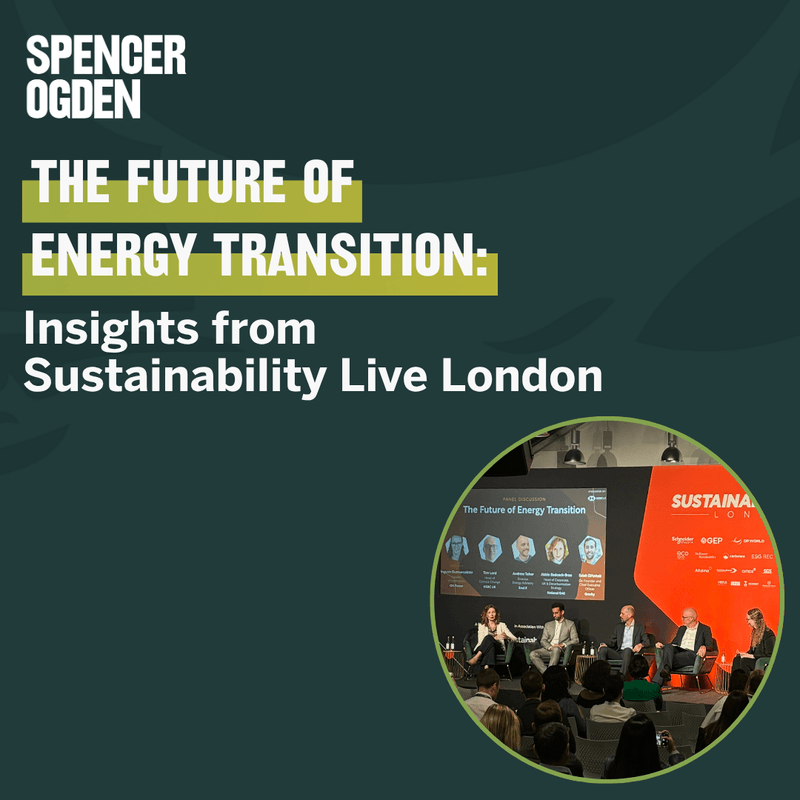The Future of Energy Transition: Insights from Sustainability Live London
At this year’s Sustainability Live in London, a standout panel brought together experts from across the energy ecosystem to tackle one of the most pressing questions of our time: what does the future of energy transition really look like? Emily Abbott, Senior Marketing Manager at Spencer Ogden attended to report on the key takeaways.
Moderated by Dr Ingunn Gunnarsdóttir of ON Power, the session featured:
- Andrew Toher, Director of Energy Advisory, Enel X
- Tim Lord, Head of Climate Change, HSBC UK
- Abbie Badcock-Broe, Head of Corporate UK & Decarbonisation Strategy, National Grid Group
- Saleh ElHattab, CEO, Gravity
Their conversation made one thing clear: the journey to net zero will be anything but straightforward. It will require unprecedented levels of investment, fresh innovation, and coordinated regulation - but it will also create opportunities for businesses bold enough to adapt.
Electrification is Inevitable - but Not Simple
Tim Lord opened with a reminder that predictions about energy are rarely perfect, but two trends are impossible to ignore. First, electrification is accelerating. Even in developed economies, electricity demand is expected to double within the next 25 years. Second, the so-called energy trilemma - the balance between affordability, security, and sustainability - will remain a defining challenge for decades to come.
The scale of investment required is staggering. Reaching global net zero by 2050 will demand around $155 trillion, highlighting just how capital-intensive the transition will be.
Policy and Market Design: A Tale of Two Worlds
For Abbie Badcock-Broe, the biggest challenge is the divergence in policy and regulation.
- In Europe, governments are moving fast to set ambitious decarbonisation targets.
- In the US, the political environment is more fragmented, with some states rolling back regulations even as others surge ahead.
This patchwork makes it hard for international businesses to plan consistently. As Tim Lord pointed out, even where technology is available, market structures like electricity pricing often lag behind, slowing down investment.
Innovation Is Critical - But So Is Scaling What Works
While shiny new technologies make headlines, the panel agreed that much of the heavy lifting will come from scaling proven solutions: solar, battery storage, and heat pumps.
That said, innovation remains vital. National Grid is already backing early-stage ideas through its venture capital arm, funding everything from AI-driven grid management to modular substations. For Gravity’s Saleh ElHattab, the biggest untapped win may be efficiency. “We waste $2 trillion of energy every year in the US alone,” he noted - savings that could transform both emissions and costs.
Breaking Down Barriers
So what’s standing in the way? Three themes dominated the discussion:
- Infrastructure bottlenecks, particularly grid capacity and slow connection queues.
- Supply chain challenges, with the need to build renewable infrastructure at scale.
- Uncertainty, leaving many businesses unsure when, and how, to invest.
Still, companies that take a proactive approach are seeing results. As Andrew Toher shared, businesses integrating sustainability, finance, and procurement functions are not just decarbonising faster, but also gaining greater cost stability and resilience.
The Hydrogen Question
No energy debate is complete without mention of hydrogen. Audience members pushed the panel on whether green hydrogen could be the silver bullet for net zero.
The answer? Not quite. While hydrogen has potential in hard-to-electrify sectors, its costs remain high, and uncertainty around offtake continues to hold back momentum. For now, it’s part of the puzzle, but not the solution.
Looking Ahead
If there was one takeaway from the session, it was this: the future of energy transition isn’t about waiting for breakthroughs. It’s about action today - scaling the technologies we already have, fixing bottlenecks in regulation and infrastructure, and ensuring businesses play their part.
The path is complex, but incremental steps, from boosting efficiency to innovating grid design, can build the foundations for long-term change. And for those ready to adapt, the opportunities are as great as the challenges.
For current market intel, check out Spencer Ogden’s Q2 Market Update report here.








